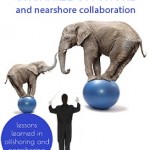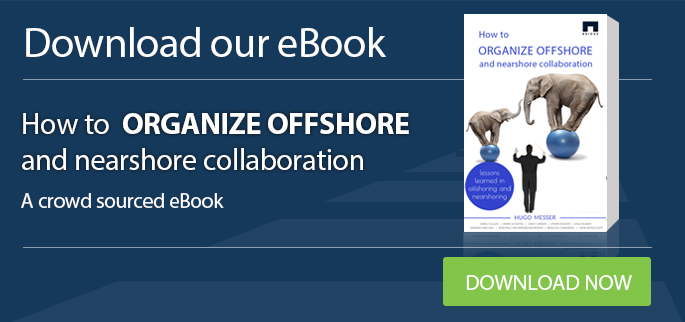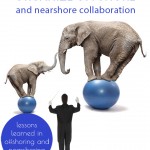How to Organize Offshore and Nearshore Collaboration?
 We recently launched our new eBook about offshoring and nearshoring :
We recently launched our new eBook about offshoring and nearshoring :
‘How to Organize Offshore and Nearshore Collaboration’
The main questions came up when managing teams that are geographically distributed are:- How do you organize a remote collaboration? What process should you introduce? How do you communicate your requirements? How do you ensure that people are doing what they are supposed to be doing? Nowadays, the technological infrastructure is in place and there are many companies working with globally distributed teams. At the same time, a lot of people look for a proven way to organize remote work. In this eBook, nine practitioners from different parts of the world and from different organizations share best practices based on their experiences.
In the first chapter, I discuss three ingredients for a successful remote collaboration – process, responsibilities, and performance. Thereby, the crucial questions such as ‘What process works best? Should you use scrum, waterfall, or something else?’ will be answered. As far as process is concerned, I describe the importance of creating clear responsibilities among the team members. Once the process is in place and people know what to do, you need to measure the outcome.
The second chapter is written by Darel Cullen who has a long and varied experience in the software industry in various sectors including nuclear, space, air traffic control, and other industries. He provides guidelines on knowledge transfer and IP protection. Many companies struggle with transferring (tacit) knowledge to their team members at a remote location. The remote team lacks the interaction that a collocated team has. Darel shares some best practices on reducing this knowledge gap.
The third chapter is written by Abhilash Chandran, an Agile Software Development Manager, coach, and practitioner, employed with Xerox Corporation. He shares his experiences on setting up a distributed Agile team in India. His expertise gives you practical insights on what roles should be performed onshore versus offshore, and what tools can best support the Agile collaboration.
How do you discuss, manage, and realize planning and deadlines? In chapter four, Andy Jordan introduces the steps to success in planning your offshore project. Andy is the President of Roffensian Consulting Inc., an Ontario, Canada-based management consulting firm with a strong emphasis on organizational transformation, portfolio management, and PMOs.
In chapter five, Erwin de Bont, who has over 20 years of experience in successfully managing many aspects of the Telecom and ICT Industry, shares his insights on good governance and multi-level KPIs in outsourcing. He uses the example of a large organization that wants to outsource many primary processes to help their customers.
In chapter six, Andreas Brilling and Anuj Kumar describe their concept on ‘how to make the waterfall model work in a multi-shore setting’. While most organizations move to Agile and scrum, the authors describe a successful implementation of waterfall and how to add Agile elements to the waterfall process. Andreas Brilling is an Engagement Manager at Capgemini based in Stuttgart. He has more than 20 years of experience in software development projects in various international settings. Anuj Kumar is a Senior Manager with Capgemini, India, based out of Mumbai. He has been working with custom software development-based projects for the past 14 years. Most of his projects involve multi-shore teams.
In the seventh chapter, Jean-Paul van Wieringhen Borski and Herke Schuffel describe the differences between offshore and nearshore collaboration, and provide suggestions to deal with them. They have developed a framework for organizing nearshore collaboration differently from offshore. Jean-Paul has 17 years of experience in the IT domain. He has spent most of his time in an international environment where he managed several offshore delivery centers. Herke has been in the IT domain for almost 20 years now. He is currently responsible for a business unit delivering application support on custom-built software with extended resource teams in Serbia and Ukraine.
In the final chapter of this eBook, Henk Woolschot, Delivery Manager at HCL, shares his insights on partnership. He draws the line between two kinds of collaborations and gives us a clear picture of when one should prefer a ‘client-supplier’ relationship over a real partnership.
This is the third eBook in a series of eBooks that will be published within a couple of months’ interval and later on into one printed book. These eBooks are being written through a crowdwriting project and the authors are experts from all over the world.
If you are interested in the upcoming eBooks or are an experienced practitioner who would like to contribute with your knowledge, please send an e-mail to h.messer@bridge-outsourcing.nl
 Wij hebben recentelijk ons nieuwe eBook gelancheerd over offshoring en nearshoring: ‘How to Organize Offshore and Nearshore Collaboration’
Wij hebben recentelijk ons nieuwe eBook gelancheerd over offshoring en nearshoring: ‘How to Organize Offshore and Nearshore Collaboration’
De belangrijkste vragen die opkwamen bij het managen van team die geografisch verdeeld zijn zijn: – Hoe organiseert u een samenwerking op afstand? Welk proces moet u introduceren? Hoe communiceert u uw eisen? Hoe bent u er zeker van dat mensen doen wat zij moeten doen? Tegenwoordig is de technologische infrastructuur op zijn plek en zijn er veel bedrijven die samen werken met teams die over de hele wereld zijn verdeeld. In dit eBook delen negen beoefenaars van verschillende delen van de hele wereld en van verschillende organisaties hun beste praktijken gebaseerd op hun ervaringen.
In het eerste hoofdstuk bediscussieer ik drie ingredienten voor een een succesvolle remote samenwerking- proces, verantwoordelijkheden en prestatie. De cruciale vragen zoals ‘Welk proces werkt het beste? Moet u scrum, waterfall of iets anders gebruiken?’ worden geantwoord. Wat het proces betreft, beschrijf ik het belang van het creëren van duidelijke verantwoordelijkheden voor verschillende teamleden. Zodra het proces op zijn plek is en de mensen weten wat ze moeten doen, kunt u de uitkomst meten.
Het tweede hoofdstuk is geschreven door Darel Cullen die een lange en gevarieerde ervaring heeft in de software industrie in verschillende sectoren inclusief nucleair, ruimte, luchtverkeersleiding en andere industrieën. Hij voorziet richtlijnen over kennis overdracht en IP bescherming. Veel bedrijven worstelen met het overdragen van kennis naar hun teamleden op een remote locatie. Darel deelt een aantal beste praktijken over het verminderen van deze kenniskloof.
Het derde hoofdstuk is geschreven door Abhilash Chandran, en Agile Software Development Manager, coach en practitioner, werknemer bij Xerox Corporation. Hij deelt zijn ervaringen over het opzetten van een distributed Agile team in India. Zijn expertise geeft u praktisch inzicht over welke taken gedaan moeten worden onshore versus offshoren en welke tools het beste de Agile samenwerking ondersteunen.
Hoe bediscussieert, managet en realiseert u planning en deadlines? In hoofdstuk vier introduceert Andy Jordan stappen voor succes in de planning van uw offshore project. Andy is de President of Roffensan Consulting Inc. een Ontario, Canada gebaseerd management consulting bedrijf met een sterke nadruk op organisatorische transformaties, portfolio management en PMOs.
In hoofdstuk vijf, deelt Erwin de Bont, die meer dan 20 jaar ervaring heeft in het succesvol managen van vele aspecten van de Telecom en ICT Industry, zijn inzichten over goed bestuur en multi-level KPIs in outsourcing. Hij gebruik het voorbeeld van een grote organisatie dat vele primaiare processen wil outsourcen om hun klanten te helpen
In hoofdstuk zes beschrijven Andreas Brilling en Anuj Kumar hun concept over ‘how to make the waterfall model work in a multi-shore setting’. Terwijl de meeste organisaties zich bewegen naar Agile en scrum, beschrijven de auteurs een succesvolle implementatie van waterfall en hoe je Agile elementen toevoegd aan het waterfall proces. Andreas Brilling is een Engagement Manager bij Capgemini gesitueerd in Stuttgart. Hij heeft meer dan 20 jaar ervaring in software development projects in verschillende internationale settings. Anuj Kumar is een Senior Manager bij Capgemini, India, gesitueerd buiten Mumbai. Hij heeft gewerkt met custom software development-based projecten voor de afgelopen 14 jaar. De meeste van zijn projecten bevatten multi-shore teams.
In het zevende hoofdstuk beschrijven Jean-Paul van Wieringhen Borski en Herke Schuffel de verschillen tussen offshore en nearshore samenwerkingen en geven ze suggesties om daarmee om te gaan. Zij hebben een framewerk ontwikkelt voor het organiseren van nearshore samenwerkingen vanuit offshore. Jean-Paul heeft 17 jaar ervaring in het IT domein. Hij spendeert het meeste van zijn tijd in een internationale omgeving waar hij verschillende offshore delivery centers managed. Herke begeeft zich nu bijna 20 jaar in het IT domein. Hij is op het moment verantwoordelijk voor een business unit delevering application support op custom-built sofware met extende resource teams in Servië en Oekraïne.
In het laatste hoofdstuk van dit eBook, deel Henk Woolschot, Delivery Manager bij HCL zijn inzichten over partnerschap. Hij trekt de lijn tussen twee verschillende samenwerkingen en geeft ons een duidelijk beeld van wanneer de voorkeur gaat naar een ‘client-supplier’ relatie of een echte partnerschap
Dit is het derde eBook in een series vanb eBooks dat gepubliseerd gaat worden met een aantal maanden interval en gaat later ook gedrukt worden. Deze eBooks worden geschreven door een crowdwriting project en de auteurs zijn experts van over de hele wereld.
Als u geïnteresseerd ben in de aankomende eBooks of heeft u ervaring als practitioner die graag zijn kennis deelt, stuur dan een email naar: h.messer@bridge-outsourcing.nl


